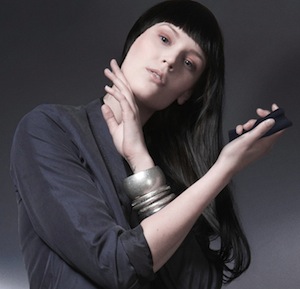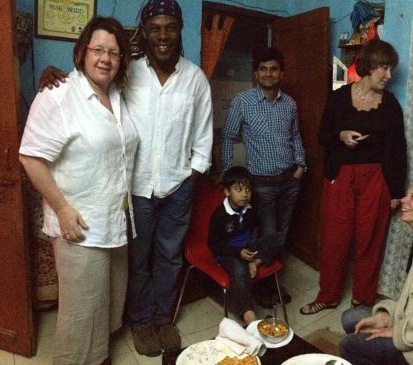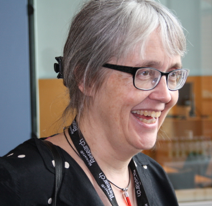August Newsletter
: What's Kicking?


Plei-Plei!: Published in 2012, this playful volume of theory and illustrations of play with technological devices was edited by researchers from Mobile Life. The book highlights mobile device design and how people use mobile devices, with a look to the future of ‘digital toys’ and mobile research.
http://shop.ppp.com.hk/product/plei-plei
http://shop.ppp.com.hk/product/plei-plei
Alumni network: The Mobile Life Centre has been home to a plenitude of researchers over the course of the past 6 years, who hail from industry, academia, and other niches. The Centre will be working on putting together an alumni network to keep its former and current members in touch. Please contact Maria Holm if you have any ideas for gatherings or networking.
[e-mail: mholm@mobilelifecentre.org]
[e-mail: mholm@mobilelifecentre.org]
New Director and Co-Director: Kristina Höök and Maria Holm are the new director and co-director of the Mobile Life Centre in Stockholm, respectively, as of March 2013. The management team will guide the directions for Mobile Life’s future work and continue the challenge that faces the research centre to create a lasting impact on society, industry and academia.
Join us on Aug 29th:
Mobile Life organizes a 'Centre day' together with the Berzelii Center Exselent and VINNOVA. The topic of the day will be the innovation climate in Sweden and Silicon Valley.
Find out more at Kalendarium.
New Moves for Former
Mobile Life Director
Mobile Life Director
Congratulations to Annika Waern and her group, on their move to Uppsala University in April!
Waern, formerly of Stockholm University, served as the Mobile Life Centre’s director since April 2012. She also headed the Mobile Life project PlaySpace, which explored how people can play games in public spaces such as malls and museums, with and without mobile technology. The program also examined how elderly people might benefit from NAO robots and physiotherapy, among other subjects.
With Waern’s departure, the PlaySpace project wrapped up in March, after a flurry of analysis and writing about the project Codename Heroes. The experimental game incorporates gender-awareness targeting teenage girls, and has the potential to be commercialized, an effort that Waern continues to explore with Mobile Life.
Kristina Höök has stepped in as director of the Mobile Life Centre, with Maria Holm as co-director. The researchers at the centre look forward to continuing their collaboration with Waern and her team in Uppsala.
Waern, formerly of Stockholm University, served as the Mobile Life Centre’s director since April 2012. She also headed the Mobile Life project PlaySpace, which explored how people can play games in public spaces such as malls and museums, with and without mobile technology. The program also examined how elderly people might benefit from NAO robots and physiotherapy, among other subjects.
With Waern’s departure, the PlaySpace project wrapped up in March, after a flurry of analysis and writing about the project Codename Heroes. The experimental game incorporates gender-awareness targeting teenage girls, and has the potential to be commercialized, an effort that Waern continues to explore with Mobile Life.
Kristina Höök has stepped in as director of the Mobile Life Centre, with Maria Holm as co-director. The researchers at the centre look forward to continuing their collaboration with Waern and her team in Uppsala.
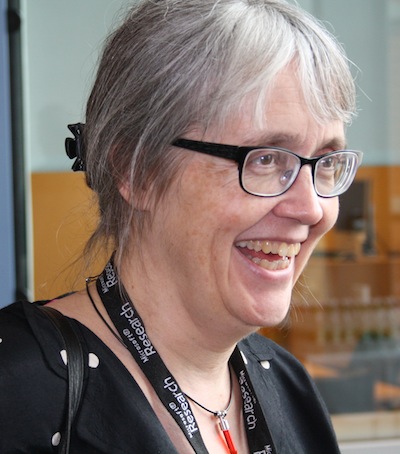
Also See:
Waern’s blog: annikawaern.wordpress.com/
PlaySpace: www.mobilelifecentre.org/node/215
www.amazon.com/Pervasive-Games-Theory-Design-Kaufmann/dp/0123748534


‘Mobility Is the Message’
People like to share, and Mattias Rost of Mobile Life wants to explore how we share on the go. Rost defended his doctoral thesis, Mobility is the Message: Experiments with Mobile Media Sharing, in March, with David Ayman Shamm of Yahoo! Research’s Internet Experiences group as his opponent. Rost’s thesis explores how four different mobile apps function, for sharing photographs, music, restaurant reviews and other information with people immediately nearby – and without a computer.
A team of researchers including Rost, based at the Future Applications Lab led by Lars Erik Holmquist, carried out their experiments at the Viktoria Institute in Gothenburg and the Mobile Life Centre in Stockholm. They tested how people used three applications that Rost helped build: Push!Music, Columbus (for photos tagged with location), and Portrait Catalog (a self-portrait photo app meant for sharing “face to face”). The team also examined how people use Foursquare, a commercial app that lets users “check in” at locations and make recommendations or post reviews.
Rost started his PhD work in 2005, before the advent of marketplaces for apps like AppStore and PlayStore. He noted in his final work that with easier online access, apps can be picked up by thousands of people very quickly; that density of users can help developers. Plus, mobile devices have since become small computers that are always online.
Those changes affect how people use apps: Rost argued that the ability to share with your immediate physical neighbors, whether close friends or perfect strangers, is an important aspect that mobile app designers often miss.
A team of researchers including Rost, based at the Future Applications Lab led by Lars Erik Holmquist, carried out their experiments at the Viktoria Institute in Gothenburg and the Mobile Life Centre in Stockholm. They tested how people used three applications that Rost helped build: Push!Music, Columbus (for photos tagged with location), and Portrait Catalog (a self-portrait photo app meant for sharing “face to face”). The team also examined how people use Foursquare, a commercial app that lets users “check in” at locations and make recommendations or post reviews.
Rost started his PhD work in 2005, before the advent of marketplaces for apps like AppStore and PlayStore. He noted in his final work that with easier online access, apps can be picked up by thousands of people very quickly; that density of users can help developers. Plus, mobile devices have since become small computers that are always online.
Those changes affect how people use apps: Rost argued that the ability to share with your immediate physical neighbors, whether close friends or perfect strangers, is an important aspect that mobile app designers often miss.

While privacy issues remain an open question, most people don’t seem to worry about divulging their details, either about their locations or other personal information.
Rost hopes his work shows how apps that are currently available might inform programmers’ creativity, and how testing can help feed into app design in the future.
Also See:
urn.kb.se/resolve?urn=urn:nbn:se:su:diva-87218
www.diva-portal.org/smash/get/diva2:602247/FULLTEXT01.pdf


Best Paper for Strong Concepts
A paper by Mobile Life researcher Kristina Höök of the Royal Institute of Technology (KTH) and her colleague Jonas Löwgren of Malmö University was chosen by the Association for Computer Machinery (ACM) as one of the best of 2012. ‘We make the rather obvious point that design research is rarely interested in constructing universal theory’, the authors write, ‘yet aims at a level of knowledge contributions that abstracts slightly from individual artifacts’. They suggest that ‘strong concepts’ could lead to the kind of midlevel knowledge that could be useful in design, without engaging in high-level academic theory.
In their paper, they note that it’s possible to come up with a core design idea without going to high-level theory, while examining interactive behaviors and practice at a basic theoretical level. The researchers present the concepts of social navigation and ‘seamfulness’—the idea that nothing is seamless in real-world technology, and that glitches and transfers from system to system should be open to users to see while they are happening.
In their paper, they note that it’s possible to come up with a core design idea without going to high-level theory, while examining interactive behaviors and practice at a basic theoretical level. The researchers present the concepts of social navigation and ‘seamfulness’—the idea that nothing is seamless in real-world technology, and that glitches and transfers from system to system should be open to users to see while they are happening.
With these ideas, Höök and Löwgren’s aim is to foster academic discourse from ideas that are design-oriented, without being too theoretical.
Citation:
Höök, K. and Löwgren, J. (2012) Strong concepts: Intermediate-level knowledge in interaction design research, ACM Transactions on Computer-Human Interaction (TOCHI), Volume 19 Issue 3, October 2012, Article No. 23, ACM New York, NY, USA.
LINK: dl.acm.org/authorize.cfm?key=6859008
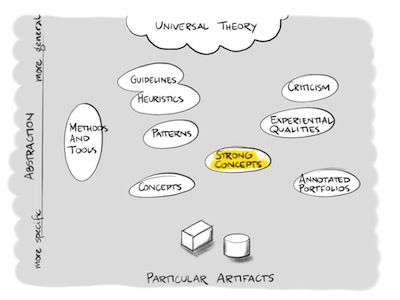


Citation:
Höök, K. and Löwgren, J. (2012) Strong concepts: Intermediate-level knowledge in interaction design research, ACM Transactions on Computer-Human Interaction (TOCHI), Volume 19 Issue 3, October 2012, Article No. 23, ACM New York, NY, USA.
LINK: dl.acm.org/authorize.cfm?key=6859008



Mobile Life in India
Mobile Life recently traveled to India and visited the cities of New Delhi, Bangalore and Chennai with a group of 15 people from the Centre’s industry partners and research organisations. The purpose of the trip was to further our understanding of research and industry in the rapidly growing mobile and home technology development in India, as well as establish working contacts and relationships with local companies and research groups in the field.
The visiting group consisted of the academic research leaders from Mobile Life and representatives from our industry partners including Ericsson, IKEA and ABB. We also did fieldwork studying life at home in India. Below is a photo from one of the home visits where Eva-Carin Banka Johnson of IKEA and Kristina Höök of Mobile Life visited Lali and her family in New Delhi.




The team
mFashion:
Fitting Phones into fashion
Fitting Phones into fashion
Yangqing Celia Zhang looks at how fashion fits to mobile life – and argues that mobile life should fit to fashion too.
Look around at the smart phones near you: they are probably clothed in a beautiful cover, perhaps with trendy patterns and colors, or even personal photos gracing their plastic cases. Phones’ fashion, however, shouldn’t stop with the phones themselves. Instead, mobile devices should be part of human fashion as well, argues Yanqing Zhang, a PhD candidate in the mFashion project at the Mobile Life Center.
Think about the most common ways that mobile devices are folded into our clothes: usually smartphones are used as timekeepers, strapped to runners’ arms, or as music-streaming devices attached to brightly colored headsets on the heads of teenagers bopping down the street. But mobile devices should be more fashionable, says Zhang. The graduate student, who goes by Celia, is also at the Department of Computer and Systems Sciences at Stockholm University, and finished her Master’s degree in 2009 at the Centre for Fashion Studies in Stockholm University.

Current fashion should be a starting point for inspiration, she says: ‘It is insightful to study the relationship between clothing and human body, between clothing and devices, and to see how we could design a mobile phone that’s connected to our garments, our appearance and the whole outfit. This is what we call “outfit-centric accessory design”, where a mobile phone is no longer treated as an isolated designed artefact, but something related to the whole display of ourselves’. Mobile phones are intimate tools on which we rely every day, so it’s not a surprise that ‘we aspire to have a phone that’s expressing “me”’, she comments.
Zhang currently is examining the history of mobile design and fashion: While classic shapes like the ‘candy bar’, ‘clamshell’ and slide phones have dominated in the past, large-faced smart phones with interactive interfaces are the current market favorite, which means that ‘every phone looks the same with a big screen’, Zhang says. That universal shape constrains what a fashion designer might create.
Look around at the smart phones near you: they are probably clothed in a beautiful cover, perhaps with trendy patterns and colors, or even personal photos gracing their plastic cases. Phones’ fashion, however, shouldn’t stop with the phones themselves. Instead, mobile devices should be part of human fashion as well, argues Yanqing Zhang, a PhD candidate in the mFashion project at the Mobile Life Center.
Think about the most common ways that mobile devices are folded into our clothes: usually smartphones are used as timekeepers, strapped to runners’ arms, or as music-streaming devices attached to brightly colored headsets on the heads of teenagers bopping down the street. But mobile devices should be more fashionable, says Zhang. The graduate student, who goes by Celia, is also at the Department of Computer and Systems Sciences at Stockholm University, and finished her Master’s degree in 2009 at the Centre for Fashion Studies in Stockholm University.

Nokia’s L’Amour Lipstick phone
nokiamuseum.info/nokia-7380
Zhang currently is examining the history of mobile design and fashion: While classic shapes like the ‘candy bar’, ‘clamshell’ and slide phones have dominated in the past, large-faced smart phones with interactive interfaces are the current market favorite, which means that ‘every phone looks the same with a big screen’, Zhang says. That universal shape constrains what a fashion designer might create.
Nokia is one of her case studies for innovation: the company has explored some ‘strange’ designs, such as the L’Amour Lipstick phone with a long slim golden case, more prosaically known as the Nokia 7380 that came out this past June. Another example is the ‘bling bling’ look of the Armani phone with LED lights on the back, which makes this and other mobile designs into ‘party phones’ that shine in the dark.
While designers have experimented with wearable technology – such as dresses with phone pockets on the arm, or wearable slings to hold mobile phones – for several years, few designs have been mass-produced or attracted interest from the larger fashion world, Zhang says. However, she wonders if that might change with new device shapes, like Google Glass, the glasses-like contraption that ‘has driven public attention to wearable devices. I think this is a big step, despite that it is still too geeky and looks weird. Fashion and technology are still so separate.’
Mobile design’s future challenges are to look to fashion for inspiration, as to how to incorporate mobile hardware into everyday wearable outfits, ‘beyond making a phone “bling bling”’. While the ‘Dick Tracy’ wearable phone watch may become a reality soon, other designs include beads with embedded technology that could hang on a necklace, or a hat with music incorporated into it.
Zhang and her colleagues want futuristic mobile design to incorporate ‘shape switching’ inspired from organic natural designs, for example. They recently created crumpled phone shapes that would match Stockholm fashions, published this year in the Proceedings of Computer Human Interactions. Zhang says: ‘I personally find [a] bendable screen or organic interface thrilling, because the stiff square screen in current smart phones could have some changes in shape if those technologies become more mature and applicable. But there is still a long way to go.
Also See:
Juhlin, O., Zhang, Y., Sundbom C., Fernaeus Y. (2013) Fashionable Shape Switching: Explorations in Outfit-centric Design in Proceedings of CHI 2013, Paris, France
PDF: mobility.dsv.su.se/files/2008/12/CHI-JO-ZY.pdf
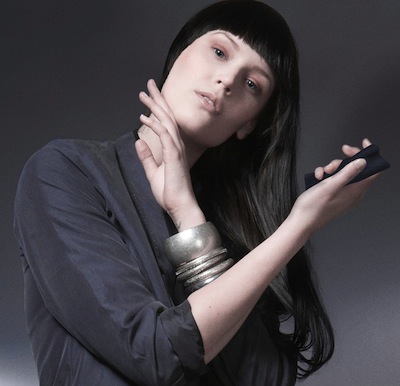


While designers have experimented with wearable technology – such as dresses with phone pockets on the arm, or wearable slings to hold mobile phones – for several years, few designs have been mass-produced or attracted interest from the larger fashion world, Zhang says. However, she wonders if that might change with new device shapes, like Google Glass, the glasses-like contraption that ‘has driven public attention to wearable devices. I think this is a big step, despite that it is still too geeky and looks weird. Fashion and technology are still so separate.’
Mobile design’s future challenges are to look to fashion for inspiration, as to how to incorporate mobile hardware into everyday wearable outfits, ‘beyond making a phone “bling bling”’. While the ‘Dick Tracy’ wearable phone watch may become a reality soon, other designs include beads with embedded technology that could hang on a necklace, or a hat with music incorporated into it.
Zhang and her colleagues want futuristic mobile design to incorporate ‘shape switching’ inspired from organic natural designs, for example. They recently created crumpled phone shapes that would match Stockholm fashions, published this year in the Proceedings of Computer Human Interactions. Zhang says: ‘I personally find [a] bendable screen or organic interface thrilling, because the stiff square screen in current smart phones could have some changes in shape if those technologies become more mature and applicable. But there is still a long way to go.
Also See:
Juhlin, O., Zhang, Y., Sundbom C., Fernaeus Y. (2013) Fashionable Shape Switching: Explorations in Outfit-centric Design in Proceedings of CHI 2013, Paris, France
PDF: mobility.dsv.su.se/files/2008/12/CHI-JO-ZY.pdf

Model dressed in “Stockholm style” carrying a shape-shifting mobile phone.


